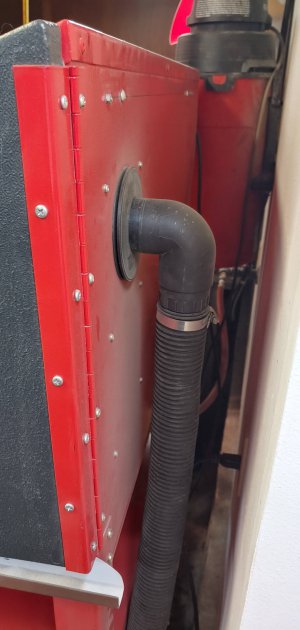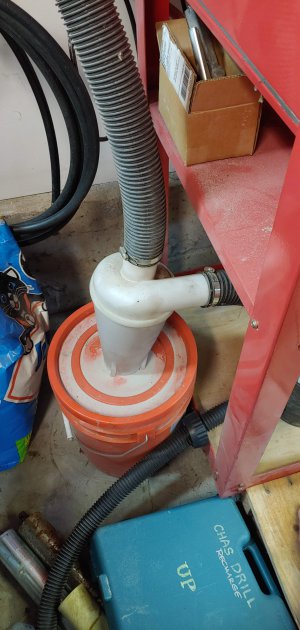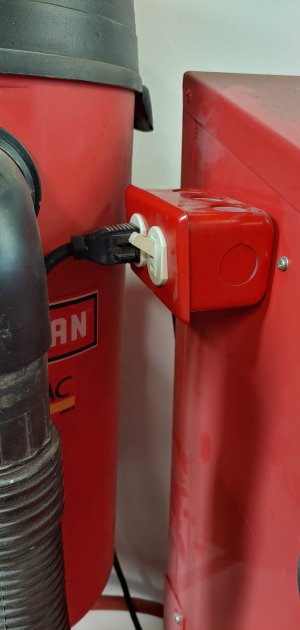I have had the larger Harbor Freight blasting cabinet for some time and it has always been hard to see what you are doing very well. It originally came with a really dim, pathetic fluorescent tube that was pretty useless. A while back I installed an under-cabinet fixture with 4 bright halogen bulbs and that helped a lot but still not good enough when the dust is flying and the film on the inside of the window is getting abraded. Before I got my mill I was looking for a bright LED solution and I settled on a pair of 48" LED "tubes" meant to retrofit into fluorescent fixtures like in suspended ceilings. I wanted as much light as possible so I ordered a pair that was too long for my cabinet, hoping I could figure out a way to shorten them, and I did.
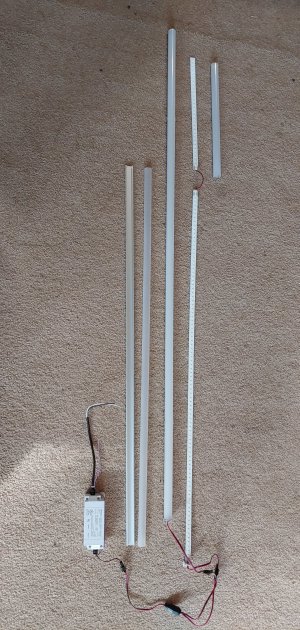
When I took apart the tubes, I found by looking closely at the copper traces on the circuit board that the LEDs were set up as groups of ten connected in parallel and then each of the 12 groups were connected in series. I decided to cut the board between groups of ten and then solder 2 jumper wires across the gap. It worked fine and so I was able to have two longer tubes and two shorter ones to completely surround the window inside the cabinet. I put the project on the back burner for a time while I thought about how I might make corner blocks to tie it all together. I was thinking hardwood but that didn't seem very cool. Then I got the mill and now I had a way to make more professional corner blocks. I obtained a length of 1.5" square high-density polyethylene as a suitable material and got to work. First, I found out the stock they cut it from was slightly under 1.5" so I squared it up to 1.450" as seen here.
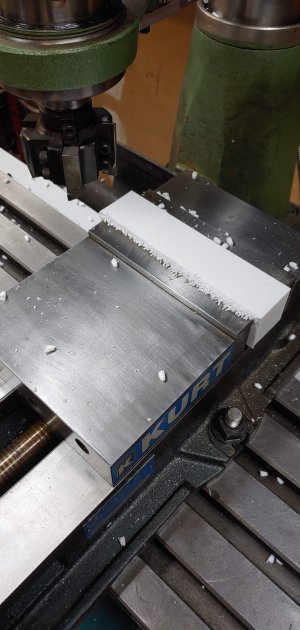
Since the tubes are about .750" in diameter but have a flat back I figured I had to make the corners in two pieces to get a proper fit. Here I have drilled .500" holes with an end mill most of the way through the block for the wires to go through and then counter boring to .750" for the tubes to go into.
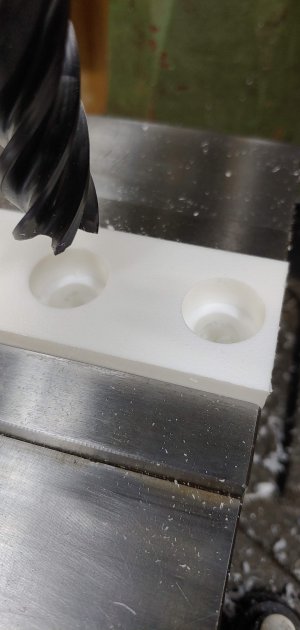
After I had done this on two adjacent sides I cut the plastic into four 1.5" blocks. Next I was going to cut each block into two pieces with one part being .500" thick for the cap but first I wanted to drill the screw holes that would hold the caps on later and I wanted to drill them before sawing them off for perfect alignment of the holes. I numbered the tops and bottoms to maintain matching pairs. I had to break out a wood working bit to drill and countersink the screw holes!
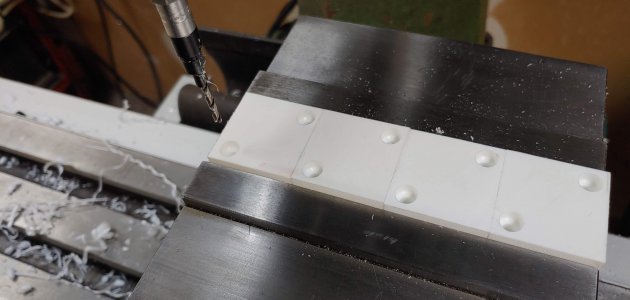
Now I sawed off the caps and lined them up in the vise to face the cut side off and mill out the .750" by .375" recesses where I would install rare-earth magnets. They are super-strong and jump to steel violently so I wanted to put them on the inside with some plastic between them and the cabinet for some control when mounting the assembly.
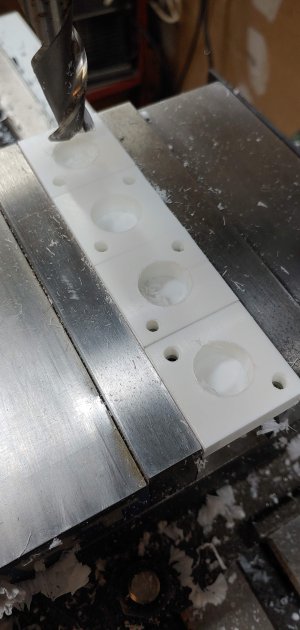
Then I clamped the remaining blocks in the vise and milled them down to the point where the flat back of the tube was about flush with the top of the block when placed in what remained of the counterbores. Here are the finished blocks and caps.
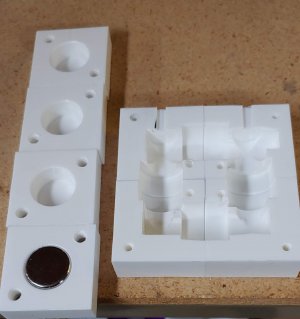
This shows how the tube ends fit into the blocks.
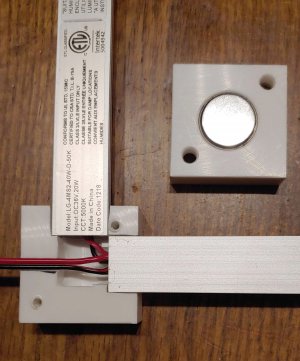
I put a narrow bead of RTV sealant around the end of each tube to anchor them into the blocks when dry. Here is the finished assembly fitted into the cabinet. Success!
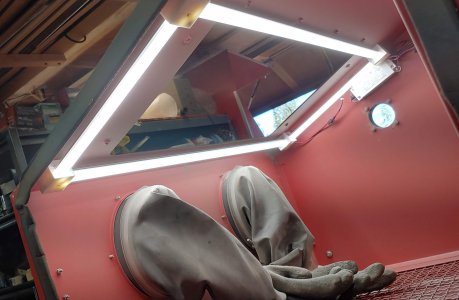
I cleaned the glass and put a new piece of protective Mylar under it and now the visibility is awesome, even brighter than the photo would suggest. I'm very satisfied with the way it came out.
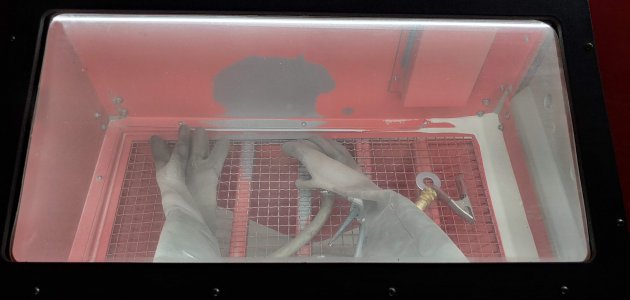
Rob

When I took apart the tubes, I found by looking closely at the copper traces on the circuit board that the LEDs were set up as groups of ten connected in parallel and then each of the 12 groups were connected in series. I decided to cut the board between groups of ten and then solder 2 jumper wires across the gap. It worked fine and so I was able to have two longer tubes and two shorter ones to completely surround the window inside the cabinet. I put the project on the back burner for a time while I thought about how I might make corner blocks to tie it all together. I was thinking hardwood but that didn't seem very cool. Then I got the mill and now I had a way to make more professional corner blocks. I obtained a length of 1.5" square high-density polyethylene as a suitable material and got to work. First, I found out the stock they cut it from was slightly under 1.5" so I squared it up to 1.450" as seen here.

Since the tubes are about .750" in diameter but have a flat back I figured I had to make the corners in two pieces to get a proper fit. Here I have drilled .500" holes with an end mill most of the way through the block for the wires to go through and then counter boring to .750" for the tubes to go into.

After I had done this on two adjacent sides I cut the plastic into four 1.5" blocks. Next I was going to cut each block into two pieces with one part being .500" thick for the cap but first I wanted to drill the screw holes that would hold the caps on later and I wanted to drill them before sawing them off for perfect alignment of the holes. I numbered the tops and bottoms to maintain matching pairs. I had to break out a wood working bit to drill and countersink the screw holes!

Now I sawed off the caps and lined them up in the vise to face the cut side off and mill out the .750" by .375" recesses where I would install rare-earth magnets. They are super-strong and jump to steel violently so I wanted to put them on the inside with some plastic between them and the cabinet for some control when mounting the assembly.

Then I clamped the remaining blocks in the vise and milled them down to the point where the flat back of the tube was about flush with the top of the block when placed in what remained of the counterbores. Here are the finished blocks and caps.

This shows how the tube ends fit into the blocks.

I put a narrow bead of RTV sealant around the end of each tube to anchor them into the blocks when dry. Here is the finished assembly fitted into the cabinet. Success!

I cleaned the glass and put a new piece of protective Mylar under it and now the visibility is awesome, even brighter than the photo would suggest. I'm very satisfied with the way it came out.

Rob


